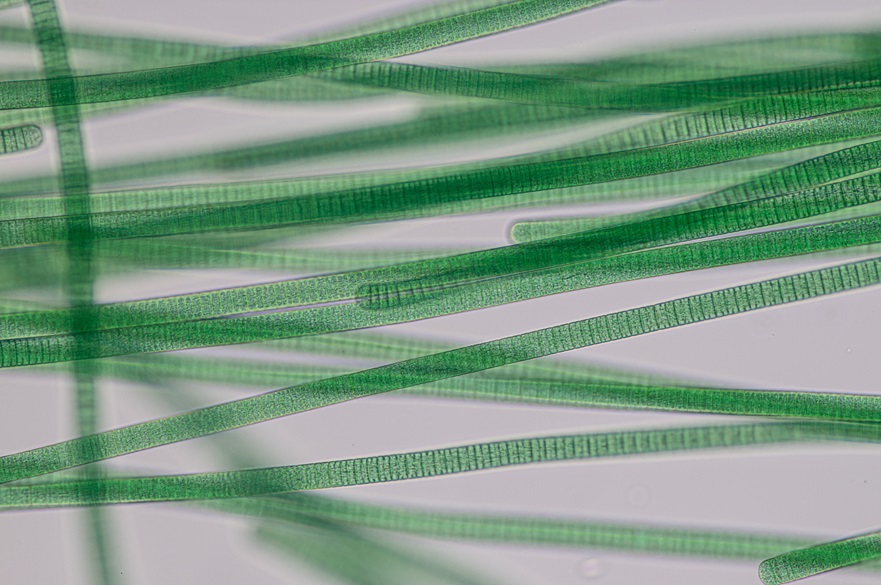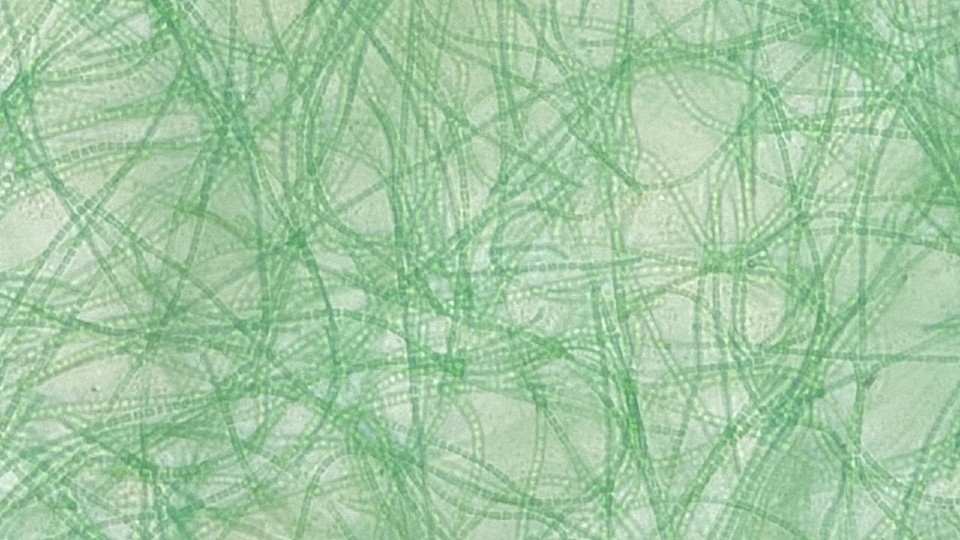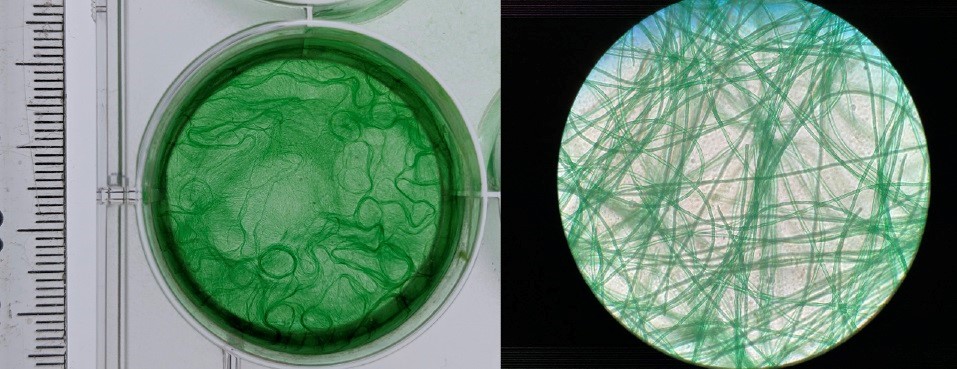Scientists unravel how ancient bacteria weave living mats – solving one of nature’s oldest mysteries
Scientists have uncovered how cyanobacteria — Earth's first photosynthetic organisms — self-organise into intricate living mats, offering insights into aquatic ecosystems and potential inspiration for material design.
By Dave Rogers | Published on 8 January 2025
Categories: Press office; Research; School of Science and Technology;

Published in Nature Communications Physics, a new study by Loughborough University and Nottingham Trent University reveals how these microorganisms transition from random, disorganised states to interwoven patterns that form ‘biomats’, uncovering the fundamental principles behind this natural phenomenon.
This feature explores the capabilities of these brilliant bacteria and how researchers unravelled one of nature’s oldest mysteries.
Why study cyanobacteria
Cyanobacteria are an ancient group of microorganisms with fossils dating back to two billion years ago. They were the first life forms on Earth capable of photosynthesising, contributing to the creation of the planet’s oxygen-rich atmosphere, which made complex life possible.
Today, cyanobacteria remain one of the largest and most significant groups of bacteria, playing a vital role in maintaining the balance of our atmosphere and oceans. They thrive in virtually all aquatic environments across the planet, including frozen Antarctic lakes.
“Cyanobacteria are ubiquitous in any body of water - sea, lakes, rivers”, explains Dr Marco Mazza, an expert in non-equilibrium physics at Loughborough University.
“They produce the lion's share of the oxygen that we breathe and form one of the bases of the food chain in the ocean.
“Understanding how they build their biomats can help us learn about their role in a variety of ecosystems, provide clues about ancient environments where life first evolved, and also inspire new materials for human use.”

Cyanobacteria filaments under a microscope.
What are biomats?
A single cyanobacterium is incredibly small, typically ranging in size from 1 to 30 micrometers (µm) in diameter, depending on the species. To put this into perspective, the thickness of a human hair ranges from about 50µm to 70µm, meaning that numerous cyanobacteria could fit side by side across its width.
Though tiny, cyanobacteria can form colonies called 'biomats', which are visible to the naked eye. These biomats often appear as slippery green slime, commonly referred to as 'blue-green algae', and can be found in stagnant water, riverbeds, and along seashores.
Biomats form when cyanobacteria link together to create thread-like filaments. As their numbers grow, these filaments, capable of moving across surfaces, weave together into intricate patterns that build the biomat structure.
Remarkably, a biomat the size of an A4 sheet can appear within hours or days and may contain hundreds of millions of cyanobacteria.
These biomats tend to make headlines when freshwater systems are polluted, as the increase of nutrients fuels rapid growth, resulting in 'algal blooms'.
The reason filamentous cyanobacteria weave together is to enhance their survival as biomats provide essential stability and protection. Once formed, the colony functions as a cohesive unit, capable of reorganising its structure in response to changes in water flow, light avaialbity, or nutrient levels, ensuring resilience even under challenging conditions.
“Essentially, cyanobacteria invented weaving and knitting before humans”, said Dr Mazza.
“And, as is often the case, we can learn new tricks from the natural world. Imagine if we could create smart clothing or responsive materials that adapt to changes in the external conditions.
“But first we need to understand how cyanobacteria arrange themselves into biomats – a mystery we are now starting to unravel.”

Green algae on the surface of water.
Unravelling cyanobacteria’s biomats
Loughborough University and Nottingham Trent University researchers have been working together to try and understand how cyanobacteria filaments arrange themselves into the patterns seen in biomats.
Using advanced microscopy techniques, simulations and theoretical models, the team previously revealed that when cyanobacteria are present at a high enough density, they begin to organise themselves into patterns by following a few simple rules.
The researchers developed a model to map this behaviour and their new study compares the model's predictions to real-world experiments.
The team cultivated a type of cyanobacteria called Oscillatoria lutea and, using a high-resolution laser scanning microscope, captured how the filaments interact and self-organise at varying densities, and how a biomat develops over time.
The results show that the model accurately captures how cyanobacteria filaments transition from a random, disorganised state to intricate, web-like patterns over time. It successfully captures both the early stages of pattern formation and the development of stable, large-scale structures.
The research also reveals that cyanobacteria filament density and motility (ability to move) play a crucial role in pattern formation, with the most organised and stable patterns emerging when filament density and motility are high.
Filament length also plays a role: longer filaments tend to form more aligned, ordered patterns, while shorter filaments create denser but less organised arrangements.

Time-lapse images show how Oscillatoria lutea filaments self-organise into intricate patterns. Panels (a–e) are microscope images of real cyanobacteria, while panels (f–k) are model simulations replicating the same conditions.
The importance of the research
Professor Lucas Goehring, who led the experimental work at Nottingham Trent University, said of the research: “This work shows how the remarkably complex behaviours of biomats, the Earth’s earliest expressions of multicellular life, can be explained by a few simple rules.
“What I found surprising is that the same rules that explain the patterns in mature biomats can also explain, without any significant adjustment, how these patterns grow up.
“The timescales and features that emerge from the model can immediately explain the first few hours of a colony’s life, as well as its ultimate shape and structure.”
When asked about the importance of the findings, study lead Dr Jan Cammann, a Research Associate in Mathematics at Loughborough University, said: “Now that we understand the mechanisms behind cyanobacteria's organisation into complex biomats, we can start to explore how cyanobacteria biomats respond to physical and chemical changes in their environment.
“Understanding this can help us understand how biomats stabilise sediments in coastal regions and understand how we can prevent biomats forming on ships and other marine structures.
“Ultimately, we hope to further the understanding of one of the most crucial members of the ecosystem whose ability to shape their environment is astonishing.”
The team say that the findings could also help guide future research into how different types of bacteria organise themselves to form structures.
“It could improve our understanding of how bacterial biofilms – collections of bacteria that have attached to a surface and each other – are formed", says Dr Cammann.
“This knowledge is critical given the central role of biofilms in various processes, such as human infections, environmental degradation, and bioengineering.”
An introduction to the cyanobacteria research.
Notes for Editors
Press enquiries please contact Dave Rogers, Public Relations Manager, on telephone +44 (0)115 848 8782, or via email.
About Nottingham Trent University
Nottingham Trent University (NTU) has been named UK ‘University of the Year’ five times in six years, (Times Higher Education Awards 2017, The Guardian University Awards 2019, The Times and Sunday Times 2018 and 2023, Whatuni Student Choice Awards 2023) and is consistently one of the top performing modern universities in the UK.
It is the 3rd best modern university in the UK (The Times and Sunday Times Good University Guide 2023). Students have voted NTU 1st in the UK for student employability (Uni Compare 2025)
NTU is the 5th largest UK institution by student numbers, with over 40,000 students and more than 4,400 staff located across six campuses. It has an international student population of almost 7,000 and an NTU community representing over 160 countries.
NTU owns two Queen’s Anniversary Prizes for outstanding achievements in research (2015, 2021). The first recognises NTU’s research on the safety and security of global citizens. The second was awarded for research in science, engineering, arts and humanities to investigate and restore cultural objects, buildings and heritage. The Research Excellence Framework (2021) classed 83% of NTU’s research activity as either world-leading or internationally excellent.
NTU was awarded GOLD in the national 2023 Teaching Excellence Framework (TEF) assessment, as it was in 2019.
NTU is a top 10 for sport (British Universities and Colleges Sport league table 2023).
NTU is the most environmentally sustainable university in the UK and second in the world (UI Green Metric University World Rankings, 2023).